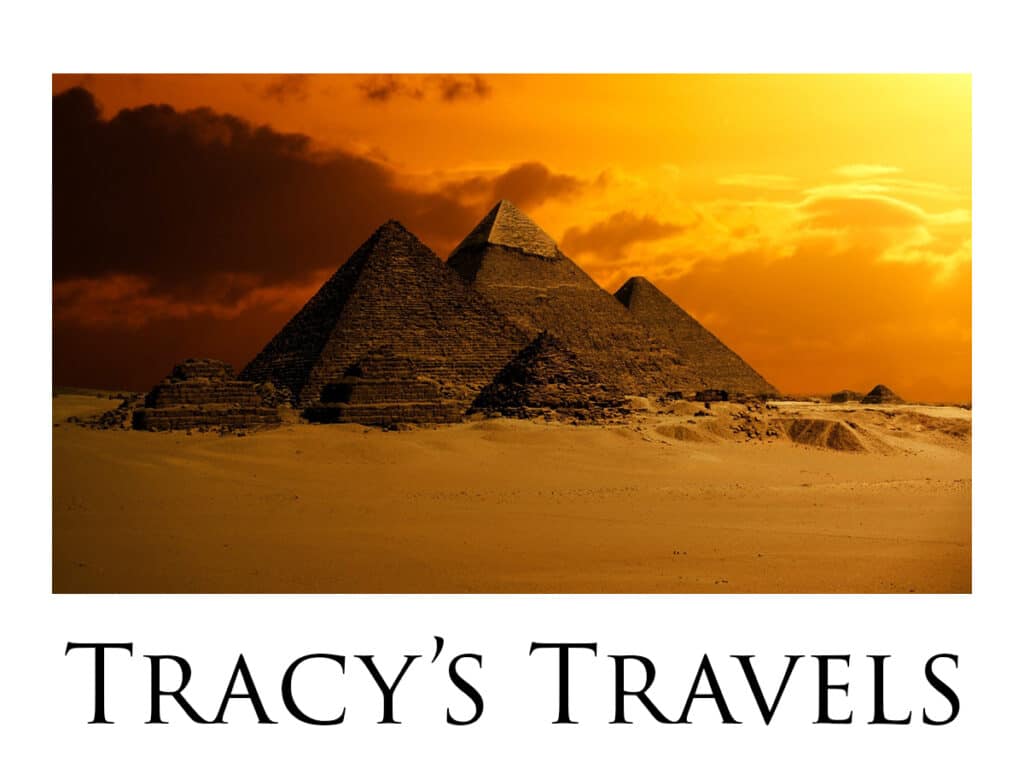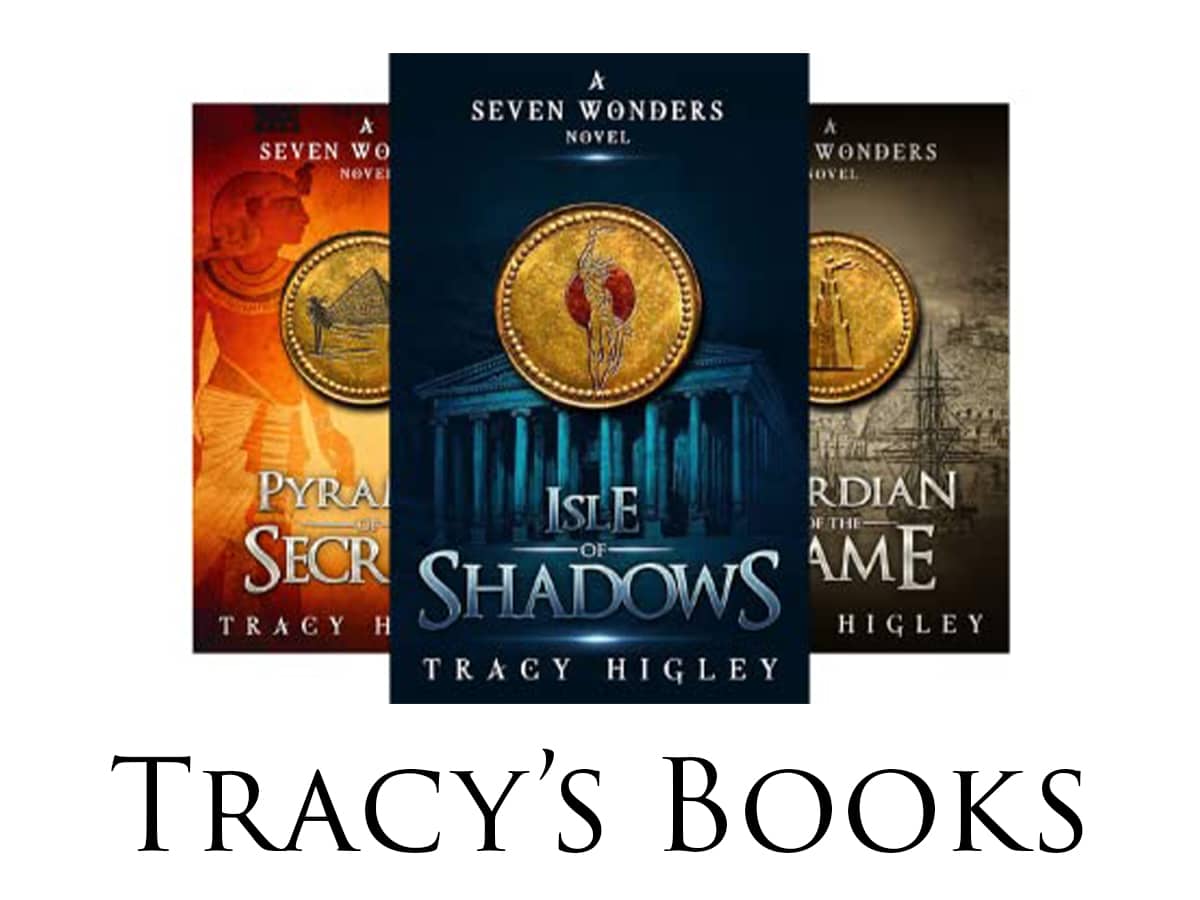The city of Alexandria on the Mediterranean coast of Egypt is the setting for Guardian of the Flame, as well as some scenes in The Queen’s Handmaid.
Follow my travels and research through the scenes of this novel.
If you haven’t read Guardian of the Flame yet, feel free to enjoy my travel journal—there are no spoilers here!
Train Ride to Alexandria

Our travels in Alexandria take place on our last research day in Egypt, where I have primarily been researching for Pyramid of Secrets, the second of the Seven Wonders novels. However, with the site of the Lighthouse of Alexandria so close, and knowing that it will be the setting for a future Seven Wonders book, we head there as a day trip, to take in whatever we can in one day.
The exhaustion of the day before has kept us in bed until a bit later, and we get a later start than planned, catching a noon train instead of 9 AM. After a taxi takes us to Ramses Station in Cairo, the driver walks us in and takes us to the ticket counter to help us buy our ticket, which seems very nice, so we tip him. Later we look at the price on the ticket and suspect he tipped himself with the change. This is not surprising for Egypt, we have discovered. The people rely on baksheesh as a way of life, and it’s hard to begrudge the small amount of money that it converts to in US dollars.
Waiting for the train, we are thirsty, but ask an Egyptian woman to get the price on a glass bottle of orange soda at the station so we won’t get ripped off. As we’re sitting on the platform, I get to thinking about all the forms of transportation we’ve taken on this trip: plane, taxi, caleche, (a horse-drawn carriage) a felucca on the Nile, subway, train, car, walking, camel, public micro-bus, airport shuttle bus, tram from ticket booth to entrance.
We finally board the train, and settle back for a relaxing two hour trip north to Alexandria (“Alex” as it’s called by the locals). Along the way we’ll see the sights, take a nap, and plan the day. I’m not sure what the day will bring. It may be long and late, or we may discover that we don’t need that much time in Alexandria.
Surprising Poverty

The train ride takes us through poorer sections of Egypt than we have yet seen, and it’s a cross-cultural experience simply watching the county go by. We see a woman and child washing clothes in the river with a stone, donkeys pulley carts, clothes hanging on every building and spread on bushes to dry by the river. We see two teens on a boat, beating something in the water with a stick, and burning reeds along the river. There is incredible poverty here. We see men pumping water out of the river, and lots of women knee deep in water. We’re not sure what they’re doing. Irrigation ditches criss-cross the fields, pulling water from the marshy Nile Delta.
Streets of Alexandria

When we get off the train, we try to find information about return trains, and are already being tailed by a hungry taxi driver. We tell him we only want to go to the catacombs, and he spends the entire drive trying to convince us to engage him for the day for 120 pounds. We say “no” a hundred times, and finally just ignore him. The chanting call to prayer begins as we drive through a tiny street. These calls are broadcast all around the city by the mosques, and for some reason I had thought that it was something pre-recorded. But as we drive through this street, the call is louder than we’ve ever heard it, and I realize that we are driving past the mosque, just a small hole in the wall of the street, and there is a man outside with a wireless microphone, chanting the call into it. Amazingly, as our taxi slows, the imam (I suppose) looks into the window and says into his microphone, “what country?” Ron answers “America,” and he says, for everyone to hear through the loudspeaker, “Welcome, welcome to Egypt” and then returns to his chanting. It seems so strange to have been part of this broadcast call to prayer.
When we got in this taxi, we felt bold enough to not negotiate a price. We just plan to give him 5 pounds when we arrive. We know it’s a fair price. When we exit the taxi, I give him the five, and he says “no, it’s ten pounds.” I laugh and shake my head wisely. “Five pounds is a fair price,” I say, and walk away. He doesn’t argue. I can hardly believe that in less than a week I’ve gained the confidence to laugh at an Egyptian taxi driver trying to cheat me.
Curious Girl

We are moving slowly through the streets, and it’s not until later, when I’m home reviewing my photos, that I realize this girl appears in many of them. She was clearly walking through the city, following us. Again I realize how few blond haired people are in this country.
Street Butcher

Catacombs

We reach the catacombs, one of the major sites to visit in Alexandria, and something we are interested in, even though they would not have existed in the first century BC, when Guardian of the Flame will be set. The site is nearly deserted, with just one Arab woman in a tiny ticket booth, and we head inside completely alone. The catacombs are carved out of some sort of porous rock, and they are like caves, twisty and windy and going off in all directions. There are hallways where you can see double high rows of tombs, perhaps twenty or thirty at a time. The halls are at right angles but branch off like a maze.
It is humid down here and warmer than I expected. There is some decoration with reliefs, pillars, and sculpture, but not much. The center of the catacomb complex is occupied by a rotunda where they lowered the bodies.
Some halls have utilitarian rows of holes, but others seem to have their own chamber, or at least a chamber for only three or four, with raised alcoves for the bodies. Wealthier people, perhaps.
We are very deep into the maze, still completely alone down here, when something happens I will never forget. The lights go out. I am totally freaked out. It is solid blackness down here, and there is no way we could find our way out without wandering for a long time. And Egypt is not the kind of place where tourist staff will come looking for you.
Ron and I hold hands and move a few feet in the dark, but mostly wonder what we are going to do. A minute or two later the lights come back on. It was a really scary few minutes, and felt literally like we were entombed. We make our way back out, and all I can think is, “I’ve got to use that in a book someday!”
First Glimpse of Alexandria Harbor

We again grab a taxi outside the catacombs. The drive from here to the citadel (the site of the Lighthouse) is through the most poverty-stricken area we’ve yet seen. The streets are so narrow they don’t seem made for vehicles.
They are thronged with people, animals, donkey carts, and garbage, and it’s nearly impossible to pass. Our taxi driver honks and weaves and I am sure we will knock someone down.
Even through the grimy taxi windows, we get stares. From children to old men, they peer into the car, point, call out to us. It feels more like a third-world country here than a thriving city on the Mediterranean.
Fort Qaitbey – Site of the Lighthouse

We are driven out to the port and dropped at the end of the causeway out to the fort. This area is much more like a sea town. Vendors along the water sell shells and sea sponges along with ancient Egyptian souvenirs, though not as many of these. We walk down to the citadel, where the Lighthouse of Alexandria would have been.
Fort Qaitbey was built in the Middle Ages, using many of the stones from the lighthouse. You can’t go inside, but it gives me a good idea of the lay of the area. The sun is starting to set, and the clouds are beautifully pink. We’re hoping to get around the harbor to the site of the Library before the sun sets completely. We walk along the quay awhile, and are only accosted once by a caleche driver. It’s a relief!
Artist Rendering of the Lighthouse

Alexandrian Harbor with Fort in Distance

Harbor

Statue of Alexander the Great

Sun Going Down on the Alexandria Harbor

We try to get a sense of how far around the harbor the newly built Bibliotheca Alexandrina is, the site of the old Library of Alexandria. It’s hard to tell, and the sun is going down. A young couple approaches and sits on the wall along the water. We ask about the distance to the library and they say we should take a taxi. As these kind Egyptian people usually do, they don’t leave us to flounder. The man walks us across the street (in the usual Frogger fashion, dodging the crazy traffic), hails a taxi for us, and tells the driver where to take us. He also tells us what to pay the driver. It’s about a mile or so to the library, around the quay, but in the usual bumper-to-bumper traffic it takes about ten minutes.
Favorite Sunset Spot

We hop out, take a look at the outside of the library, and realize it’s just a big library. No real need to go inside. We cross a divided highway to get to the water, and watch the sun go down over the fort. The wall here is lined with couples. Definitely a place to go on a date!
Night Streets of Alexandria

It’s been a whirlwind trip through Alexandria, but it doesn’t seem like there’s much more to see, so we decide to grab another taxi, and perhaps get an earlier train back to Cairo. It’s another harrowing journey back through the streets to the train station and when we arrive we learn that we can’t get another train for 90 minutes. We venture back into the Alexandria streets to kill some time, and find ourselves in the local shopping area, with an outdoor market and lots of street vendors. The city is absolutely filthy, like nothing I’ve seen. This is not the tourist part of town.
It’s dark now, and there’s a party atmosphere, with hundreds of people crowding the streets as we walk. We reach a meat vendor, and find a newly-butchered sheep lying in our path on the sidewalk. The entire upper half of the sheep is intact, with head and wool and forelegs. The back half of the sheep is gone, presumably hanging somewhere close by. Around the half-sheep is a six-foot wide puddle of bright red blood pooling in the street and sidewalk. We have to step around the blood to continue on our way. I glance down the alley here and see three or four more sheep standing a few feet away, mutely watching the crowd pass by. They have no idea of their fate.
We look through shops for socks for Ron (whose luggage still has not caught up with us), but find only dress socks. It is soon time to turn around and head back to the train station. We take the second-class train back to Cairo to save a little money. It’s not much different, except considerably dirtier. It’s a long 2 hours, but all in all, it was worth the trip. The walk around the harbor, from the site of the Lighthouse to the site of the Library, has given me good fodder for the next Seven Wonders novel, Guardian of the Flame.








